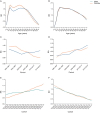Global Trends in the Incidence of Anxiety Disorders From 1990 to 2019: Joinpoint and Age-Period-Cohort Analysis Study
- PMID: 38285497
- PMCID: PMC10862248
- DOI: 10.2196/49609
Global Trends in the Incidence of Anxiety Disorders From 1990 to 2019: Joinpoint and Age-Period-Cohort Analysis Study
Abstract
Background: Anxiety disorders (ADs) are the most common mental illness with high prevalence, chronicity, and comorbidity. Despite rapid economic and cultural development, the global incidence of ADs continues to increase, with predominance in male individuals.
Objective: To address the above issues, we analyzed the dynamic trends of the global incidence and disease burden of ADs from 1990 to 2019 and their different effects on age, period, and birth cohort and predicted the future trend of AD incidence.
Methods: The data were obtained from the Global Burden of Disease study in 2019. A joinpoint regression model was used to calculate the annual percent change in AD incidence, and age-period-cohort analysis was used to estimate the independent effects of age, period, and cohort. Nordpred age-period-cohort analysis was used to predict the incidence of ADs from 2020 to 2044.
Results: The age-standardized incidence rate of ADs increased by 1.06% for both sexes, and the age-standardized disability-adjusted life-year (DALY) rate (ASDR) decreased by 0.12%. Joinpoint regression indicated that increments in average annual percent changes in the age-standardized incidence rate (0.068 vs 0.012) and ASDR (0.035 vs -0.015) for ADs globally were higher among male individuals than female individuals. The age-period-cohort analyses revealed that the relative risk (RR) of the incidence and DALYs of ADs among people of different sexes increased with age in adolescence and middle age and then decreased. For the period effect, the RR of incidence decreased, whereas the RR of DALYs increased in both sexes. Moreover, the RR of the incidence gradually increased and DALYs slowly decreased with birth year for both male and female individuals. New cases of ADs in male individuals are predicted to increase in the coming 25 years.
Conclusions: This study provided the changing trend of the global incidence and disease burden of ADs in the past 3 decades, indicating that early prevention and effective control cannot be ignored. We analyzed the age-period-cohort effect of potential trends in ADs and predicted future incidence trends. The results suggest that we should take active intervention measures, focusing on high-risk groups and developing effective management and control policies to reduce the global burden of disease.
Keywords: DALYs; age-period-cohort analysis; anxiety disorders; disability-adjusted life-years; incidence; joinpoint regression model; prediction.
©Huiru Cao, Yang Wu, Hui Yin, Yanqi Sun, Hui Yuan, Mengjun Tao. Originally published in JMIR Public Health and Surveillance (https://publichealth.jmir.org), 29.01.2024.
Conflict of interest statement
Conflicts of Interest: None declared.
Figures




Similar articles
-
Burden of uterine cancer in China from 1990 to 2021 and 15-year projection: a systematic analysis and comparison with global levels.Reprod Health. 2024 Oct 10;21(1):144. doi: 10.1186/s12978-024-01882-2. Reprod Health. 2024. PMID: 39390595 Free PMC article.
-
Age-period-cohort analysis and prediction of tuberculosis trends in China-based on the Global Burden of Disease 2021 data.Front Public Health. 2025 Feb 14;13:1512514. doi: 10.3389/fpubh.2025.1512514. eCollection 2025. Front Public Health. 2025. PMID: 40027502 Free PMC article.
-
Global incidence, prevalence, years lived with disability (YLDs), disability-adjusted life-years (DALYs), and healthy life expectancy (HALE) for 371 diseases and injuries in 204 countries and territories and 811 subnational locations, 1990-2021: a systematic analysis for the Global Burden of Disease Study 2021.Lancet. 2024 May 18;403(10440):2133-2161. doi: 10.1016/S0140-6736(24)00757-8. Epub 2024 Apr 17. Lancet. 2024. PMID: 38642570 Free PMC article.
-
Global and China trends and forecasts of disease burden for female lung Cancer from 1990 to 2021: a study based on the global burden of disease 2021 database.J Cancer Res Clin Oncol. 2025 Feb 8;151(2):68. doi: 10.1007/s00432-025-06084-2. J Cancer Res Clin Oncol. 2025. PMID: 39921760 Free PMC article. Review.
-
The changes in global burden of autoimmune diseases two years after the COVID-19 pandemic: a trend analysis based on the Global Burden of Disease Study 2021.J Transl Autoimmun. 2025 Apr 24;10:100289. doi: 10.1016/j.jtauto.2025.100289. eCollection 2025 Jun. J Transl Autoimmun. 2025. PMID: 40342869 Free PMC article. Review.
Cited by
-
A generational relational model of nature and mental wellbeing: results of a qualitative analysis.Front Psychol. 2025 Mar 24;16:1469507. doi: 10.3389/fpsyg.2025.1469507. eCollection 2025. Front Psychol. 2025. PMID: 40196201 Free PMC article.
-
Effects of otolaryngological diseases on sleep quality, anxiety, and depression: a multicenter observational study.BMC Psychiatry. 2025 Feb 13;25(1):124. doi: 10.1186/s12888-025-06531-x. BMC Psychiatry. 2025. PMID: 39948523 Free PMC article.
-
Anxiety in Portugal: Associated Factors in Adult Population from 2011 to 2021.J Clin Med. 2025 Jun 10;14(12):4100. doi: 10.3390/jcm14124100. J Clin Med. 2025. PMID: 40565848 Free PMC article.
-
Augmented Reality as an Aid to Behavior Therapy for Anxiety Disorders: A Narrative Review.Cureus. 2024 Sep 15;16(9):e69454. doi: 10.7759/cureus.69454. eCollection 2024 Sep. Cureus. 2024. PMID: 39282478 Free PMC article. Review.
-
People are increasingly bored in our digital age.Commun Psychol. 2024 Nov 3;2(1):106. doi: 10.1038/s44271-024-00155-9. Commun Psychol. 2024. PMID: 39489856 Free PMC article. Review.
References
-
- Penninx BW, Pine DS, Holmes EA, Reif A. Anxiety disorders. Lancet. 2021;397(10277):914–927. doi: 10.1016/S0140-6736(21)00359-7. https://europepmc.org/abstract/MED/33581801 S0140-6736(21)00359-7 - DOI - PMC - PubMed
-
- Bandelow B, Michaelis S. Epidemiology of anxiety disorders in the 21st century. Dialogues Clin Neurosci. 2015;17(3):327–335. doi: 10.31887/DCNS.2015.17.3/bbandelow. https://europepmc.org/abstract/MED/26487813 - DOI - PMC - PubMed
Publication types
MeSH terms
LinkOut - more resources
Full Text Sources
Medical
Miscellaneous

